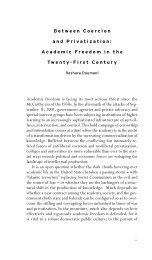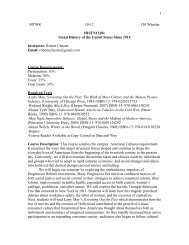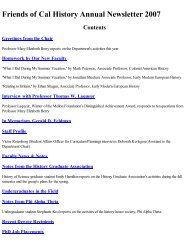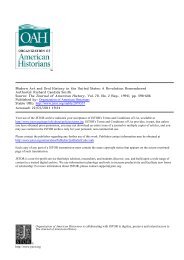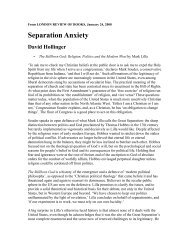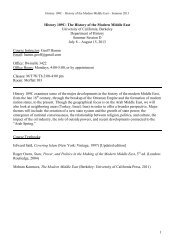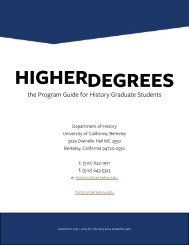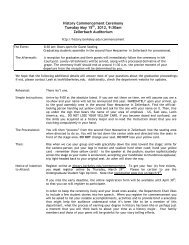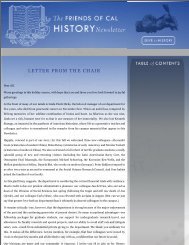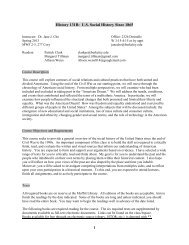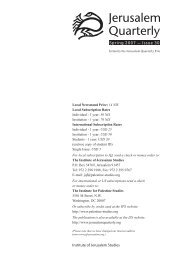David A. Hollinger | Amalgamation and Hypodescent: The Question ...
David A. Hollinger | Amalgamation and Hypodescent: The Question ...
David A. Hollinger | Amalgamation and Hypodescent: The Question ...
You also want an ePaper? Increase the reach of your titles
YUMPU automatically turns print PDFs into web optimized ePapers that Google loves.
direct descendants of people who had been. 17 Second, the United States was the most self-consciouslyimmigrant-based society in all of Europe <strong>and</strong> North America, distinguished even from Canada by theproportion of its population derived from outside Great Britain <strong>and</strong> France <strong>and</strong> by the fact that Canadadid not have a citizenship law to distinguish its own nationality from that of the British Empire until1947. <strong>The</strong> foreign-born population of the United States between 1860 <strong>and</strong> 1930 ranged between 11.6percent <strong>and</strong> 14.7 percent, <strong>and</strong> a much larger percentage than that of white inhabitants throughout thoseseventy years were, of course, the children or gr<strong>and</strong>children of immigrants.A third condition helps make the United States a setting in which our question is importantly 14engaged: the presence of Indians, or at least the presence of those indigenous people who were left afterthe slaughters <strong>and</strong> disease-caused deaths that accompanied the occupation of their l<strong>and</strong> by Europeans.Yet the Indian case was sufficiently different from both the African-American case <strong>and</strong> that of theEuropean immigrants to st<strong>and</strong> somewhat outside the miscegenation conversation <strong>and</strong> the melting potconversation. Indians had been enslaved episodically in the British colonies of North America, butIndian slavery was never a significant feature of labor systems in the United States. Twelve states didinclude Indians in their miscegenation statutes, but enforcement was often lax. <strong>The</strong> Virginia law did notinclude Indians because a motion to include them was defeated by Tidewater aristocrats who claimed tobe the descendants of John Rolfe <strong>and</strong> Pocahontas. For all the anti-Indian behavior <strong>and</strong> attitudes on thepart of the white population, the latter often nourished an idealized view of the "noble savage," whichhistorians have shown coexisted with the most genocidal of dispositions. Millions of white Americanshave bragged that they had "Indian blood," <strong>and</strong> often cited it by quantum, as in "I'm one-eighthCherokee." <strong>The</strong> appropriation of Indian l<strong>and</strong> was accompanied by an extensive appropriation of theIndian genetic heritage <strong>and</strong> Indian symbolic identification with America. <strong>The</strong> topic of white-Indianmixture was most often discussed in terms of blood quantum, not only by federal officials but also bytribal governments <strong>and</strong> in everyday conversation on the part of whites. 18<strong>The</strong> affirmation of Indian ancestry proceeds apace in our own time. In the twenty years between 151970 <strong>and</strong> 1990, the federal census reported an increase of 259 percent in the American Indianpopulation despite a very low birthrate. What had happened, of course, is that more <strong>and</strong> moreAmericans decided to "come out" as part Indian. 19 <strong>The</strong> American Indian population, even as exp<strong>and</strong>ed,remains a tiny fraction of the nation—about 1 percent—but it dem<strong>and</strong>s mention on account of thecontrast it presents to the African-American case. We do not see a multitude of ostensibly whiteAmericans reclassifying themselves as part black. 20<strong>The</strong> stigma carried by blackness is unique, <strong>and</strong> is affixed <strong>and</strong> perpetuated resolutely by the 16American practice of treating blackness as a monolithic identity that an individual either has or does nothave on the basis of the principle that any African ancestry at all determines that one is simply black. 21<strong>The</strong> invidiousness of this "one-drop rule" was eloquently encapsulated by Barbara Fields more thantwenty years ago: we have a convention "that considers a white woman capable of giving birth to ablack child but denies that a black woman can give birth to a white child." 22 One has not been able tosay, "I'm one-eighth African American" without giving up socially, if not legally, the seven-eighths partof one's self that is not. You can be one-eighth Cherokee <strong>and</strong> still be seven-eighths something else, butif you are one-eighth black you are not likely to be counted as white at all. Indeed, one index of thepower of the one-drop rule for blacks is that some Indian tribal governments have recently tried to expelfrom tribal membership long-time members who have demonstrably black ancestors. 23Comparativists have often commented on the uniqueness to the United States of this principle of 17hypodescent. 24 <strong>The</strong> principle is widely taken for granted in the United States right down to the present,<strong>and</strong> is even defended as a political strategy in some contexts by organizations speaking for the interestsof African Americans. 25 But the principle originates in the property interests of slaveholders. Childrenbegotten upon slave women by their owners or by other white men would grow up as slaves, adding tothe property of the owners of the women <strong>and</strong> preserving the amazingly durable fiction that male



